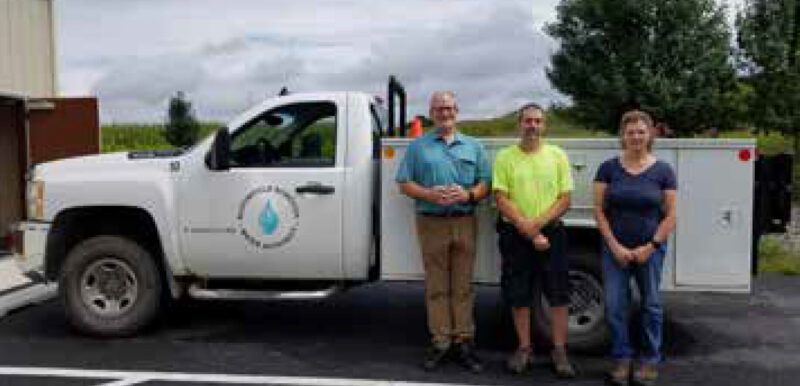
Currently, the Bloomfield Borough Water Authority (BBWA) provides drinking water to a population of approximately 1,100 people in Perry County, southcentral Pennsylvania. Bloomfield Borough is the county seat of Perry County, which was created on March 22, 1820, from part of Cumberland County. It was named in honor of Oliver Hazard Perry, victor in the Battle of Lake Erie. Bloomfield, the county seat after 1827, bears the name given to the tract of land in the original patent. It is said that it was laid out in the month of June 1822, when clover was in bloom. It was incorporated as a borough on March 14, 1831. The post office name for Bloomfield is New Bloomfield.
The original water supply was a spring that can still be seen next to Main Street, nestled on the west edge of the small downtown area around the courthouse. It lacked the capability for source water protection and ability to provide adequate pressure for piped water. When piped water came in the 1920s, the Thebes Spring was developed just below a ridge line northwest of town. It is located in Centre Township, supplying approximately 60 gallons per minute (gpm). A gravity line from the spring, leads to a larger stone-concrete reservoir at the northwest edge of the Borough limits. Later, a second small reservoir was built on the Carson Long Military School campus just north and up the hill from the center of town.
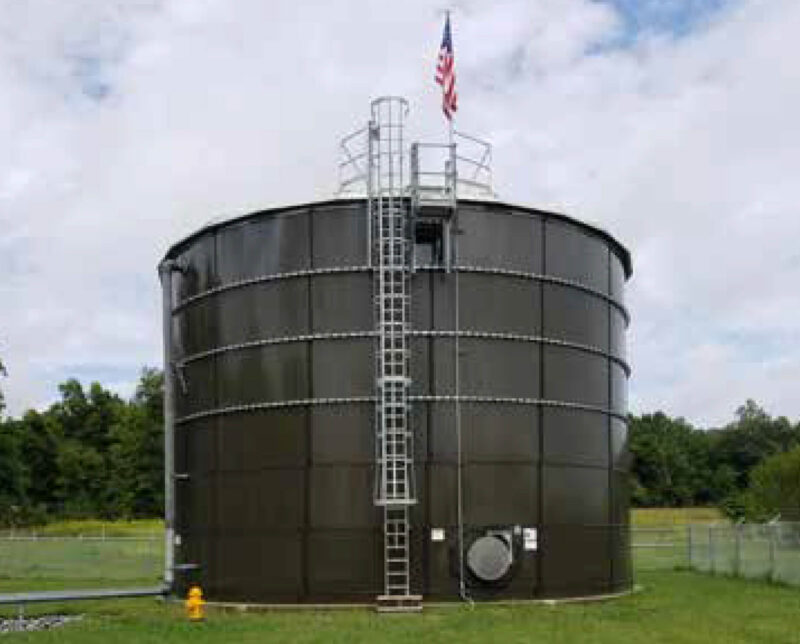 Chlorination came to the spring in the 1970s and the reservoirs were covered in the early 1980s in response to evolving mandates. Bigger changes came in the 1990s when the spring needed to be evaluated for surface water influence (SWI). Mike Scheffey, longtime water operator, started his career with BBWA carrying out the SWI protocol (SWIP) and the Thebes Spring came to be listed as under surface water influence. Around the same time a nearby family illegally dumped waste on two properties over 10 years instead of transporting it to permitted landfills, according to a DEP consent decree. Groundwater wells were drilled rather than to construct a surface water treatment plant on the spring.
Chlorination came to the spring in the 1970s and the reservoirs were covered in the early 1980s in response to evolving mandates. Bigger changes came in the 1990s when the spring needed to be evaluated for surface water influence (SWI). Mike Scheffey, longtime water operator, started his career with BBWA carrying out the SWI protocol (SWIP) and the Thebes Spring came to be listed as under surface water influence. Around the same time a nearby family illegally dumped waste on two properties over 10 years instead of transporting it to permitted landfills, according to a DEP consent decree. Groundwater wells were drilled rather than to construct a surface water treatment plant on the spring.
Well 1 was drilled in the early 1990s off Fenicle Hill Road, in the southwestern part of the Borough behind the Perry County Prison, to supplement the spring. Well 2 was drilled nearby in 1997 and reconstructed in 1999 as the spring was being abandoned. A tiny building was erected to feed chlorine, and pyrophosphate corrosion inhibitor. Administrative secretary Jeanne Fry worked from home, and Mike worked from his truck. While either well has a pumping rate of around 80 gpm, the Susquehanna River Basin Commission (SRBC) mandated that only one or the other was to be pumped at a time.
Unfortunately, the Fenicle Hill wells were shortly observed to exhibit severe drop-off of water levels during late summer conditions. During a 2005 drought, pumping both wells 1 and 2 was necessary, but resulted in a consent order from DEP. To further stabilize the water supply in 2006 and 2007, BBWA interconnected with and assumed control of the water system at Perry Village skilled nursing facility on the east edge of the Borough. The facility operated Well PV-1 rated at 25 gpm and Well PV-2 at 45 gpm.
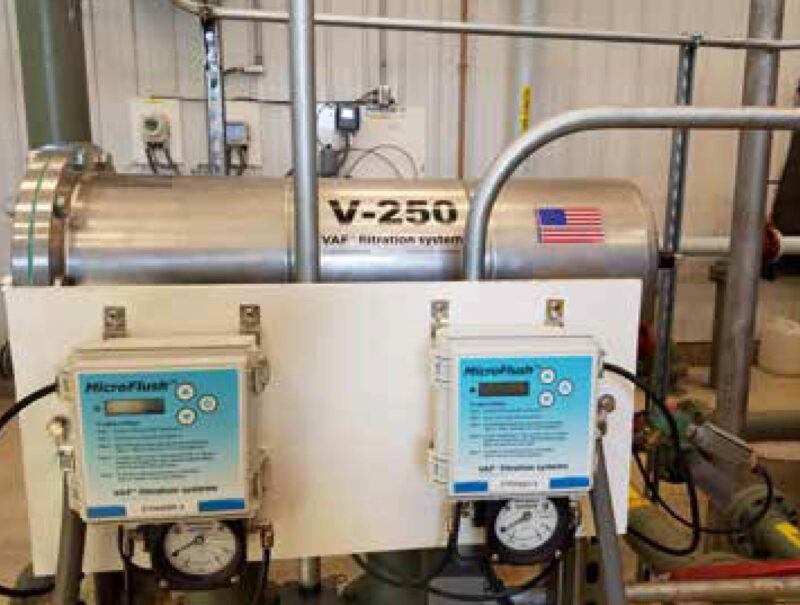 A 300,000 gallon Aquastore glass-fused to steel water storage tank was also constructed on the hill south of the prison. The Perry Village wells would also drop-off in late summer, and their interconnection occurred without SRBC pre-approval eliciting another compliance consent order. In the 31 years that Mike worked for the water system, every year but one required issuance of a drought watch or warning. New developments within the Borough or just outside in Centre Township could not be connected. On February 15, 2007, no water was available at the Perry County Prison next to the wells. DEP provided an emergency permit that day to reactivate the Thebes Spring, on an unfiltered basis with a boil-water advisory and mandatory water restrictions. BBWA also activated its interconnection with water that could be spared from Carson Long Military Academy. On May 8, 2007, Well No. 2 collapsed, and a contractor had to restore the pump at a higher setting that day. Clearly, an additional source was needed, though letting all the inmates out of the county prison and taking them down to the DEP office in Harrisburg might have been thought of as an alternative.BBWA engaged GeoServices, Ltd. in 2006 to perform a well siting study, and a promising location was found just at the northeast edge of the Borough. BBWA purchased property from a farm family during a divorce settlement, and Well 3 was drilled in 2010, reconstructed in 2012, and tested at 210 gpm in 2015. Glace Associates, Inc. (Bob Reisinger then Pete Fleszar, project managers) was engaged to design a groundwater treatment plant feeding hypochlorite and pyrophosphate, and repumping from a ground storage tank to system pressures. USDA Rural Development obligated a $2,597,100 loan in August 2016, for the well completion, new storage tank and line replacement.
A 300,000 gallon Aquastore glass-fused to steel water storage tank was also constructed on the hill south of the prison. The Perry Village wells would also drop-off in late summer, and their interconnection occurred without SRBC pre-approval eliciting another compliance consent order. In the 31 years that Mike worked for the water system, every year but one required issuance of a drought watch or warning. New developments within the Borough or just outside in Centre Township could not be connected. On February 15, 2007, no water was available at the Perry County Prison next to the wells. DEP provided an emergency permit that day to reactivate the Thebes Spring, on an unfiltered basis with a boil-water advisory and mandatory water restrictions. BBWA also activated its interconnection with water that could be spared from Carson Long Military Academy. On May 8, 2007, Well No. 2 collapsed, and a contractor had to restore the pump at a higher setting that day. Clearly, an additional source was needed, though letting all the inmates out of the county prison and taking them down to the DEP office in Harrisburg might have been thought of as an alternative.BBWA engaged GeoServices, Ltd. in 2006 to perform a well siting study, and a promising location was found just at the northeast edge of the Borough. BBWA purchased property from a farm family during a divorce settlement, and Well 3 was drilled in 2010, reconstructed in 2012, and tested at 210 gpm in 2015. Glace Associates, Inc. (Bob Reisinger then Pete Fleszar, project managers) was engaged to design a groundwater treatment plant feeding hypochlorite and pyrophosphate, and repumping from a ground storage tank to system pressures. USDA Rural Development obligated a $2,597,100 loan in August 2016, for the well completion, new storage tank and line replacement.
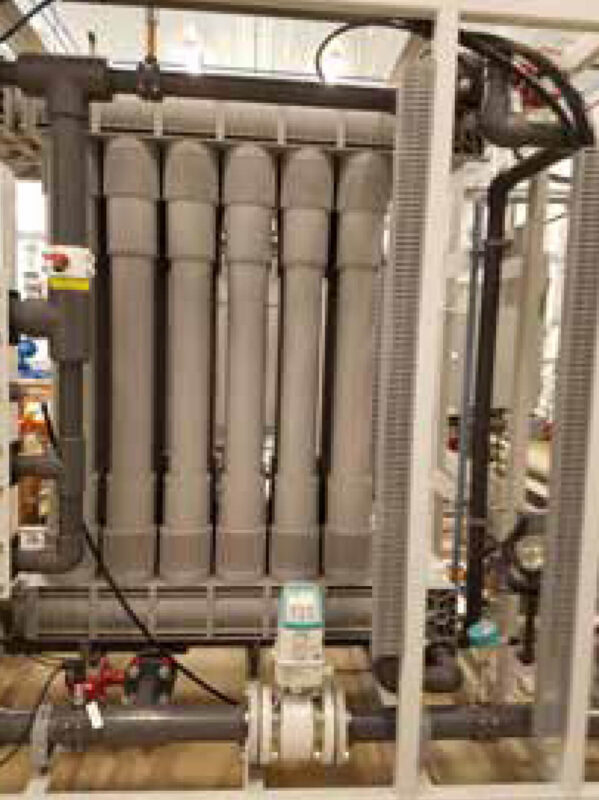 DEP issued a construction permit in November 2016, but mandated a full SWIP on the well. BBWA, Glace, and USDA worked together to identify how the pumping for the SWIP testing could occur. Electrical power was extended to the site, BBWA pre-purchased the well pump and meter, and PSI Pumping Solutions received a bid to provide temporary facilities. Mike ran the SWIP test from May to November 2017, then DEP required a microscopic particulate analysis in February 2018. DEP issued a groundwater under direct influence (GUDI) determination letter in March 2018. DEP offered BBWA a choice either to treat GUDI, attempt to reconstruct the well, or abandon the well and start over. Meanwhile, the clock was ticking not only on the USDA financing, but SRBC’s approval of Well 3.
DEP issued a construction permit in November 2016, but mandated a full SWIP on the well. BBWA, Glace, and USDA worked together to identify how the pumping for the SWIP testing could occur. Electrical power was extended to the site, BBWA pre-purchased the well pump and meter, and PSI Pumping Solutions received a bid to provide temporary facilities. Mike ran the SWIP test from May to November 2017, then DEP required a microscopic particulate analysis in February 2018. DEP issued a groundwater under direct influence (GUDI) determination letter in March 2018. DEP offered BBWA a choice either to treat GUDI, attempt to reconstruct the well, or abandon the well and start over. Meanwhile, the clock was ticking not only on the USDA financing, but SRBC’s approval of Well 3.
GeoServices evaluated the possibilities of reconstruction or development of a new source. They stated that due to the relative shallowness of the water bearing zone, reconstruction was unlikely to provide many benefits. Furthermore, finding another source was not likely, given how the community had already tried areas to the northwest, southwest, and southeast. BBWA reluctantly decided that GUDI treatment would be needed. USDA obligated an additional loan of $1,868,000 in August 2018.
Following a meeting with DEP, package rapid rate filtration, pressure filtration, and membrane filtration were carried forward into the next step of alternatives determination. Mike and Pete traveled to other nearby treatment plants with pressure filtration, conventional filtration, and different membrane microfiltration systems. BBWA chose the Memcor technology due to its anticipated lower installed cost than other membrane technology vendors, following Site visits and contact with other systems indicated Memcor’s responsiveness in the event repairs or replacement parts are needed. Glace then prepared the pilot protocol. BBWA hired a contractor to run an 800’ pressure sewer connection, and Mike carried out the pilot test in a temporary shelter from October 2018 through February 2019. Mike also performed Long Term 2 Enhanced Surface Water Treatment Rule (LT2ESWTR) bin testing that DEP required from May 2018 to May 2019. Chairman Ed Albright tracked the water they paid to pump down a swale; the final total was 25 million gallons.
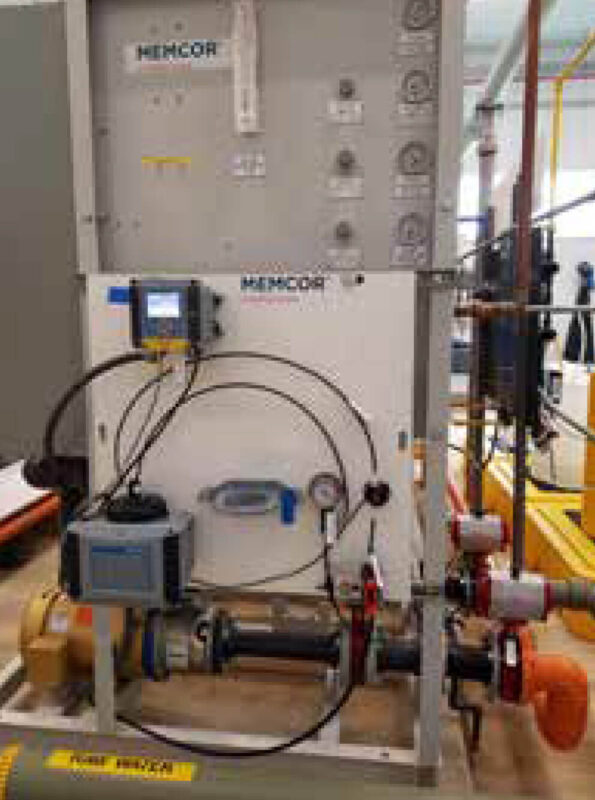 DEP issued a revised construction permit for the membrane treatment on December 24, 2019. In order to show activity on the construction to preserve some of the regulatory approvals, with DEP’s and USDA’s permission, BBWA had already bid the construction of the new 300,000 gallon Aquastore water tank on the Well 3 site, a near twin to the Fenicle Hill tank. Due to a nearby wetland, the earth disturbance had to be limited to less than 1.0 acre on the entire property, including an 800-foot long driveway and the water line. By sequencing contractors back to front, BBWA to meet this requirement of staying within its “magic acre.”
DEP issued a revised construction permit for the membrane treatment on December 24, 2019. In order to show activity on the construction to preserve some of the regulatory approvals, with DEP’s and USDA’s permission, BBWA had already bid the construction of the new 300,000 gallon Aquastore water tank on the Well 3 site, a near twin to the Fenicle Hill tank. Due to a nearby wetland, the earth disturbance had to be limited to less than 1.0 acre on the entire property, including an 800-foot long driveway and the water line. By sequencing contractors back to front, BBWA to meet this requirement of staying within its “magic acre.”
Bids for the general and electrical construction of the Water Treatment Plant at Well No. 3 were received on March 23, 2020, literally just as the COVID-19 shutdowns were impacting the USA. Ed decided to proceed with general contractor M2 Construction, LLC and electrical contractor HRI, Inc. Continuing ahead at that time of great uncertainty, in retrospect avoided most of the supply chain and inflation issues that bedeviled the country in 2021 and 2022. Two pump booster skids were shipped to M2 from Texas just before the bad winter storms there in early 2021, and the emergency generator was also received early before the consequent availability crunch. The water treatment plant project was substantially complete in August 2021 and received its interim operation permit in September 2021. Despite all the setbacks, and also replacing the last
Continued on from Previous Page blocks of in-service asbestos-cement pipe, abandoning Well PV-1 to satisfy SRBC approval conditions, the project was completed just below the $4,465,100 USDA financing amount.
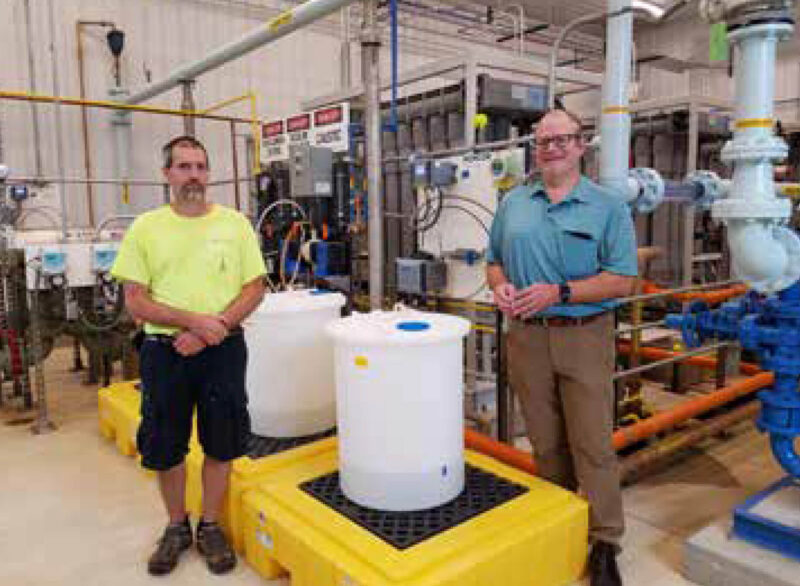 Mike oversaw day-to-day construction and Pete came every week to check on progress. Larry Fisher was hired as construction began to back-stop operations for Mike. Ed wondered why the white rooms with 16’ ceilings and bright motion-sensitive LED illumination were needed, until filled with color-coded pipes to and fro, tanks, two air compressors, and other items of equipment costing over a million dollars. Just as the initial reporting requirements for DEP came about, Mike retired in December 2021, leaving cartoons throughout the plant on his last day for Larry to discover. Pete had to keep visiting every week as the system’s certified operator until Larry became a fully certified operator with subclass 6. Larry had labeled all the pipes and tanks with how to mix the chemicals, just in case someone else had to step in and run the plant in a pinch. Unfortunately, that precaution proved necessary when Larry was suddenly taken ill at the end of March 2022 and Pete had to actually mix chlorine and phosphate, not just witness air hold tests.
Mike oversaw day-to-day construction and Pete came every week to check on progress. Larry Fisher was hired as construction began to back-stop operations for Mike. Ed wondered why the white rooms with 16’ ceilings and bright motion-sensitive LED illumination were needed, until filled with color-coded pipes to and fro, tanks, two air compressors, and other items of equipment costing over a million dollars. Just as the initial reporting requirements for DEP came about, Mike retired in December 2021, leaving cartoons throughout the plant on his last day for Larry to discover. Pete had to keep visiting every week as the system’s certified operator until Larry became a fully certified operator with subclass 6. Larry had labeled all the pipes and tanks with how to mix the chemicals, just in case someone else had to step in and run the plant in a pinch. Unfortunately, that precaution proved necessary when Larry was suddenly taken ill at the end of March 2022 and Pete had to actually mix chlorine and phosphate, not just witness air hold tests.
BBWA gradually increased its rates during the project to $112.90 minimum quarterly and $11.29 per 1000 gallons above base, and continues to maintain positive cash flow. The largest property within the Borough, Carson Long Military Academy, closed. DEP and the Borough required a new owner to connect to BBWA as soon as the water would become available, due to long-term issues with the Carson Long water system. BBWA received an H2O PA grant to support the redevelopment of the Carson Long campus into Talmudic University of Pennsylvania. A water booster station is currently under construction within the former small reservoir, minimizing impact to the surrounding historic campus to supply up to 100 gpm of water to the topographically higher campus buildings.
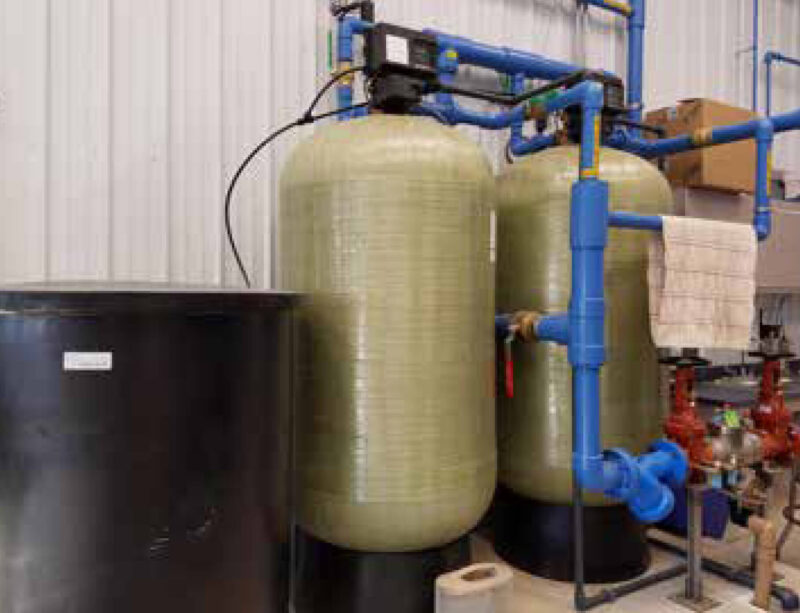 The 80,000 to 90,000 gallon per day typical demand on the system is met roughly half-and- half by the remaining wells (Well 1 or 2, and PV-2), and by Well 3. BBWA policy is to maximize the water that can be produced from the older wells, at a lower cost per gallon, and preserving all the wells in operational status. The Well 3 treatment is housed within a reinforced post-frame building. Raw water pumped from Well 3 first flows through one of two parallel 100-micron auto-backflushing strainers, then is divided into one of three membrane skids rated at up to 141 gpm each, with 18 Memcor L10 membranes. Polyaluminum chloride pretreatment is permitted, but has not been necessary in the first year of operation. Typical operation is 125 gpm through two skids at a time, three to four days per week during duty hours for the operational team. Filtered water enters an HDPE tank that provides suction to filtrate pumps. Sodium hypochlorite and polyphosphate are then added paced by the flow in the filtrate line, that then enters a 165-foot long 48” ductile iron pipe with sufficient contact time for 1-log Giardia inactivation in the event of a treatment breakdown. Entry point sampling is drawn from the inlet pipe to the 300,000 gallon tank, and the inlet is above high water level in that tank, so required contact time is totally independent of the level in the large storage tank. A service water pump skid (containing 2-60 gpm variable speed pumps, 2-500 gpm variable speed high flow pumps) draws flow from the 300,000 gallon storage tank to system pressure, locally 55 psi. Clean-in-place (CIP) water for membrane maintenance is drawn from the system side of the service water pump skid. Water softeners sized for a 60 gpm flow rate (as desired by Memcor engineers) soften the CIP water stored in a second HDPE hot water tank that supports the membrane skid maintenance wash and CIP cycles.
The 80,000 to 90,000 gallon per day typical demand on the system is met roughly half-and- half by the remaining wells (Well 1 or 2, and PV-2), and by Well 3. BBWA policy is to maximize the water that can be produced from the older wells, at a lower cost per gallon, and preserving all the wells in operational status. The Well 3 treatment is housed within a reinforced post-frame building. Raw water pumped from Well 3 first flows through one of two parallel 100-micron auto-backflushing strainers, then is divided into one of three membrane skids rated at up to 141 gpm each, with 18 Memcor L10 membranes. Polyaluminum chloride pretreatment is permitted, but has not been necessary in the first year of operation. Typical operation is 125 gpm through two skids at a time, three to four days per week during duty hours for the operational team. Filtered water enters an HDPE tank that provides suction to filtrate pumps. Sodium hypochlorite and polyphosphate are then added paced by the flow in the filtrate line, that then enters a 165-foot long 48” ductile iron pipe with sufficient contact time for 1-log Giardia inactivation in the event of a treatment breakdown. Entry point sampling is drawn from the inlet pipe to the 300,000 gallon tank, and the inlet is above high water level in that tank, so required contact time is totally independent of the level in the large storage tank. A service water pump skid (containing 2-60 gpm variable speed pumps, 2-500 gpm variable speed high flow pumps) draws flow from the 300,000 gallon storage tank to system pressure, locally 55 psi. Clean-in-place (CIP) water for membrane maintenance is drawn from the system side of the service water pump skid. Water softeners sized for a 60 gpm flow rate (as desired by Memcor engineers) soften the CIP water stored in a second HDPE hot water tank that supports the membrane skid maintenance wash and CIP cycles.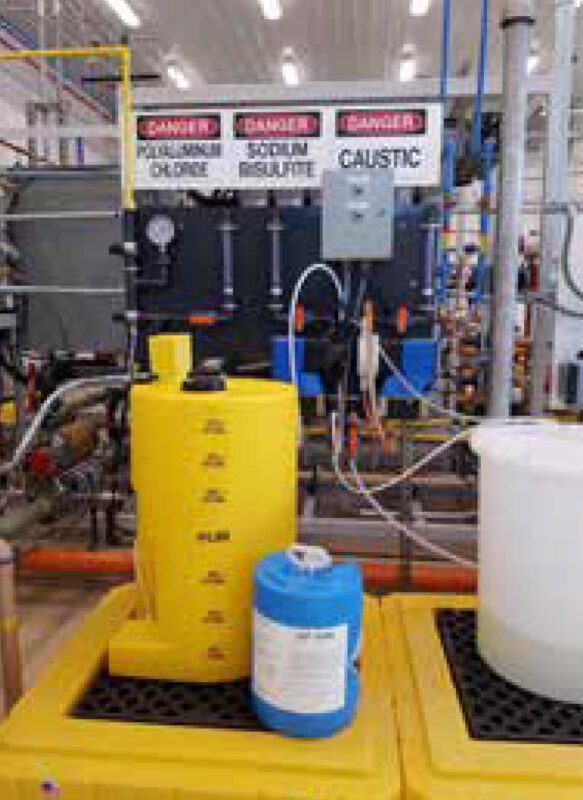 Return flows from backwash, CIP, and filtrate exhaust are conveyed to a 25,000 gallon concrete tank located below the treatment plant floor, with neutralization, sodium bisulfite and/or caustic is fed as directed by the master control panel for the membrane system for neutralization. Orenco effluent pumps convey the waste flows periodically at 25 gpm through an 800-foot 2” pressure sewer line to the gravity sewer in East Main Street. The Borough sewer operator has reported he does not even notice these flows at their SBR treatment plant.
Return flows from backwash, CIP, and filtrate exhaust are conveyed to a 25,000 gallon concrete tank located below the treatment plant floor, with neutralization, sodium bisulfite and/or caustic is fed as directed by the master control panel for the membrane system for neutralization. Orenco effluent pumps convey the waste flows periodically at 25 gpm through an 800-foot 2” pressure sewer line to the gravity sewer in East Main Street. The Borough sewer operator has reported he does not even notice these flows at their SBR treatment plant.
A small office and bathroom on the end of the water treatment plant provides workspace for the BBWA water operator and part-time administrator, currently Denice Fisher. While a dedicated computer assembling data for DEP reporting mirrors the human-machine interface (HMI) of the membrane system master control panel, its connection to the Internet is physically unplugged unless BBWA initiates contact with Memcor or its control provider, Control Systems 21. Remote notification and alarms are consolidated into cellular OmniSite remote notification from system sites. There is no off-site remote control of any system critical functions. Authority meetings are still held at the Borough meeting room. Seasonal non-potable bulk water is dispensed as permitted by DEP through a hydrant on the 8” line at the end of the treatment plant driveway. The valve is locked with the lock combination known to only registered haulers, and the station is under 24/7 camera surveillance, as is the entire treatment plant property.
During the dry late summer of 2022, well flows from Well 3 were slightly increased to enable lower withdrawals from the old drought affected wells. Until further development occurs to consume the reserve demand within SRBC’s overall system limit of 180,000 gpd, BBWA can now even sell bulk
water by the tanker load, during conditions that until 2022 would have put the town into drought watch. Finally, after many years of efforts of BBWA staff, Board members, and ratepayers, a new and secure water treatment system should serve area residents and even the county prison inmates for years to come.
BBWA’s next challenge arises from bottlenecks within its distribution system. One block of 2” line between Well 3 and the Fenicle Hill tank limits the ability to fill the tank on the hill from the new water treatment plant to approximately 70 gpm before the service pumps trip on pressure. There is an 8” line from the new plant that only goes to Main Street, where water tankers fill at typically 450 gpm. Most lines through town are only 6” and 4”, so fire flow cannot be guaranteed in this older, more densely developed community. BBWA identified the worst bottlenecks on its system mapping and is pursuing funding of further line replacement in three relatively small areas.

